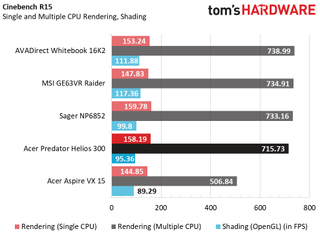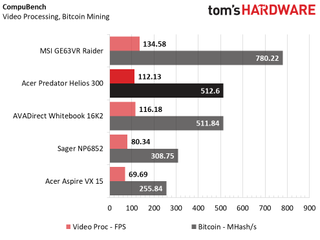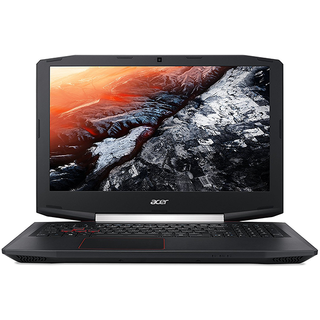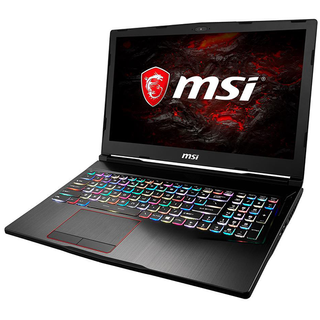Acer Predator Helios 300 Gaming Laptop Review: A New Value King
Why you can trust Tom's Hardware
Synthetic Benchmarks
The Acer Predator Helios 300 ticks off all of the basic necessities you might expect from a gaming laptop. It contains Intel’s 7th-generation Core i7-7700HQ processor, an Nvidia GeForce GTX 1060, and 16GB of memory (at 2133MHz speeds). Storage is handled by a lone 256GB M.2 SSD. The display is a 15.6” Full HD (1920x1080) matte IPS display with a 60Hz refresh rate. There isn’t anything particularly special going on inside the Predator Helios 300, but that might just be where its charm lies. No unnecessary additions, only pure performance at a palpable price.
Now for the competition.
The recently reviewed AVADirect Whitebook 16K2 is a thin-and-light gaming laptop, matching the Acer’s specs with an i7-7700HQ CPU, a GTX 1060 GPU, and 16GB of DDR4 memory clocked at 2400MHz. It relies on a single 250GB M.2 SSD. Similarly, it has a 15.6” FHD matte IPS display. On paper, the Acer and AVADirect laptops are almost identical, and considering the latter is a thin-and-light, the main performance differences are likely to come down to battery life, thermal dissipation, and display accuracy. Its price, when we tested it, was also $1,849.
Next up we have a more powerful GTX 1070-based laptop: the MSI GE63VR Raider. It has an i7-7700HQ, a 512GB M.2 SSD, and a 1TB 7200RPM HDD. The Acer is missing that hard drive. It also has double the memory at 32GB of DDR4-2400. The Raider uses a 15.6” FHD matte display, but it has a different display technology and a higher 120Hz refresh rate. The Raider will be the highest end system in our comparison, and its price is double that of the Acer.
Going down the scale, we have the Sager NP6852, a Clevo-based laptop. The NP6852 features an i7-7700HQ, 16GB of DDR4-2400 memory, and a 256GB M.2 SSD. The NP6852 is more budget oriented than the Predator Helios, because it uses a GTX 1050 Ti. It has 15.6” FHD matte IPS display, much like the Predator and Whitebook. The Sager ran $1,300 when we tested it.
Finally, we couldn’t leave out Acer’s even more price-conscious entry, the Aspire VX 15. It’s the lowest end laptop in our comparison, sporting an Intel Core i5-7300HQ, a GTX 1050, and 8GB of DDR4-2400 memory. For storage, it utilizes a 256GB M.2 SSD. Its display is a 15.6” FHD matte TFT display. Based on looks, the Predator and Aspire are incredibly similar, but we don’t expect performance to be close.
3DMark



3DMark’s game-like workloads give us a sneak peak of our gaming results.
As expected, the Acer Predator Helios 300 performs about as well as the AVADirect Whitebook 16K2 because both use GTX 1060s. Both the Helios 300 and Whitebook perform considerably better than the Sager 8156 and Aspire VX 15, but they don’t come anywhere close to dethroning the MSI Raider and its beefy GTX 1070.
Cinebench R15

3DMark is our main graphical synthetic benchmark, whereas Cinebench measures CPU prowess, particularly the single and multi-core tests. On the other hand, the OpenGL shading test is platform-based, with a slight preference for GPU strength.
Because each of the laptops except the Aspire VX 15 contain an i7-7700HQ, the single and multi-core scores are largely similar. The Aspire’s weaker i5 processor lands its multi-core score nearly 30% lower than the Helios 300. In OpenGL shading, the Raider reigns supreme with a 23% lead over the Helios.
CompuBench

CompuBench features a handful of benchmarks; we use the platform-based Video Processing test and GPU-based Bitcoin Mining test.
The Predator Helios and Whitebook go head-to-head once again in both metrics. Similarly, the Predator outperforms the NP6852 and Aspire on all accounts, and is defeated by the Raider. The GTX 1050 and GTX 1050 Ti fall short of the GTX 1060 by 38% and 28%, respectively, in Video Processing and 50% and 40%, respectively, Bitcoin Mining.
IOMeter


We perform an IOmeter test on each laptop’s primary drive to measure basic random and sequential read and write speeds. The Helios 300 contains a 256GB Micron 1100. The MSI sports a 512GB Samsung PM871. The AVADirect utilizes a 250GB Samsung 960 EVO. The Sager has a 256GB Sandisk X400. Finally, the Aspire has a 256GB LiteOn CV3.
In 4K random (QD2) speeds, the Micron 1100 lands the Predator in the middle of the pack, so while it’s not as impressive as Samsung SSDs in the Whitebook and Raider, you’ll still get respectable performance. However, the Micron 1100 struggles in 128K sequential speeds, which is a weak point for most of the SSDs in this roundup. This means that the Predator won’t be able to access large files, like movies and 4K photos as quickly as, say, the AVADirect.
PCMark 8

To approximate a system’s common workday performance, we use PCMark 8’s Microsoft Office and Adobe Creative tests. The tasks are platform-based, so systems with powerful CPUs will perform the better. Naturally, then, the Acer Predator Helios 300 doesn’t perform much differently than the other 7700HQ-based laptops. The Aspire VX 15 scores considerably worse because it’s bottlenecked by its inferior CPU.
MORE: Best Gaming Laptops
MORE: Gaming Laptop Previews
MORE: All Laptop Content
Current page: Synthetic Benchmarks
Prev Page Introduction & Product Tour Next Page Gaming BenchmarksStay on the Cutting Edge
Join the experts who read Tom's Hardware for the inside track on enthusiast PC tech news — and have for over 25 years. We'll send breaking news and in-depth reviews of CPUs, GPUs, AI, maker hardware and more straight to your inbox.
-
AgentLozen ReplyAlexander Quejado said:Acer has done a stellar job with the Predator Helios 300. It offers gaming performance that’s unparalleled at its price point, making it our top value choice for gaming laptops.
This laptop wasn't given an award? I was under the impression that hardware that performs well and was an excellent value for it's class usually got editor awards.
/shrug -
chequecer60 Come on guys. This laptop has the same specs, plus an RGB keyboard, USB 3.1 Type-C and Display Port. $999 before shipping. If you use their promo code it's $949.Reply
https://www.cyberpowerpc.com/system/Halloween-Tracer-II-15-VR
Make sure to get the free mouse pad. -
anbello262 Reply20324198 said:Alexander Quejado said:Acer has done a stellar job with the Predator Helios 300. It offers gaming performance that’s unparalleled at its price point, making it our top value choice for gaming laptops.
This laptop wasn't given an award? I was under the impression that hardware that performs well and was an excellent value for it's class usually got editor awards.
/shrug
Maybe the article was silently updated, but I can clearly see that it does have an award... -
AgentLozen I see that now. I'm 99% confident that award wasn't there when I originally posted that message. Best explanation is that either 1. I'm blind or 2. The article was ninja-editedReply -
DuncDog There were some things missing from this review that seems out of place given the normal processes for Tom's Hardware Reviews... CPU Stress Testing, CPU Temperature Testing, CPU/GPU Throttling Testing, Audio Ramp Up of Fan Assembly?Reply
I only recalled seeing NotebookCheck's review back in August of an almost identical sku Helios 300, and seeing markedly different results here in so far as Temps are concerned.
>For instance, here is a direct quote from their review of the cooling assembly:
"Our stress test showed that the heat produced by the CPU and GPU is not transported out of the case fast enough. We measured a maximum CPU temperature of 97 °C (~206.6 °F). Nonetheless, the CPU managed to keep up the core clock rate over the entire one-hour test period. The maximum temperature we measured on the GPU was 84 °C (~183.2 °F). It has no thermal throttling."
>Where was any of that here? They also noted this about the fan assembly on their unit:
"What bothered us, however, was the high-frequency noise that the fans started emitting at partial load."
Unless Acer pulled a massive factory side initiative to resolve both of those issues, there seem to be some pits in the Tom's Review of this Laptop because the striking difference in readings gives the impression of 2 entirely different pieces of hardware. We are taking order of magnitude differences here. 97C vs ~60C on CPU and 82C vs 67C on the 1060s.
Here is the other review for reference:
https://www.notebookcheck.net/Acer-Predator-Helios-300-7700HQ-GTX-1060-Full-HD-Laptop-Review.242962.0.html


